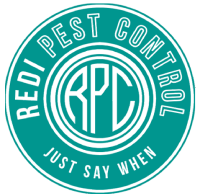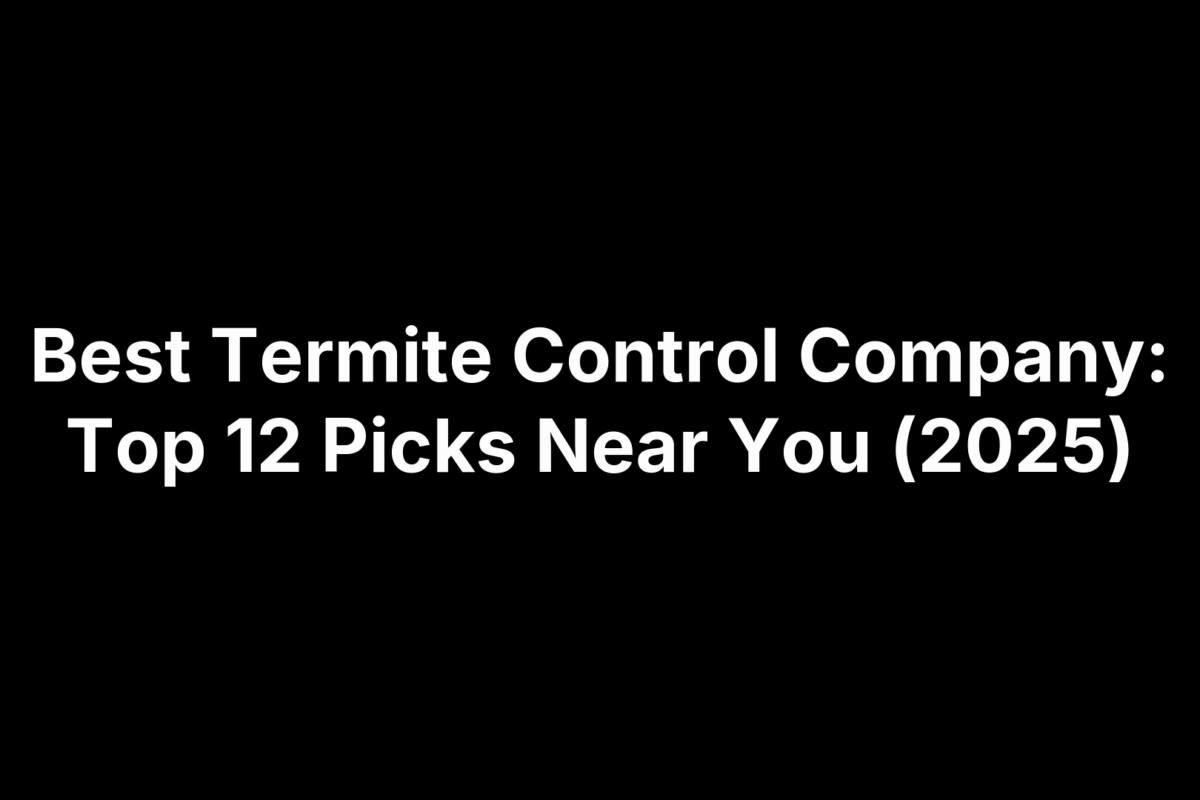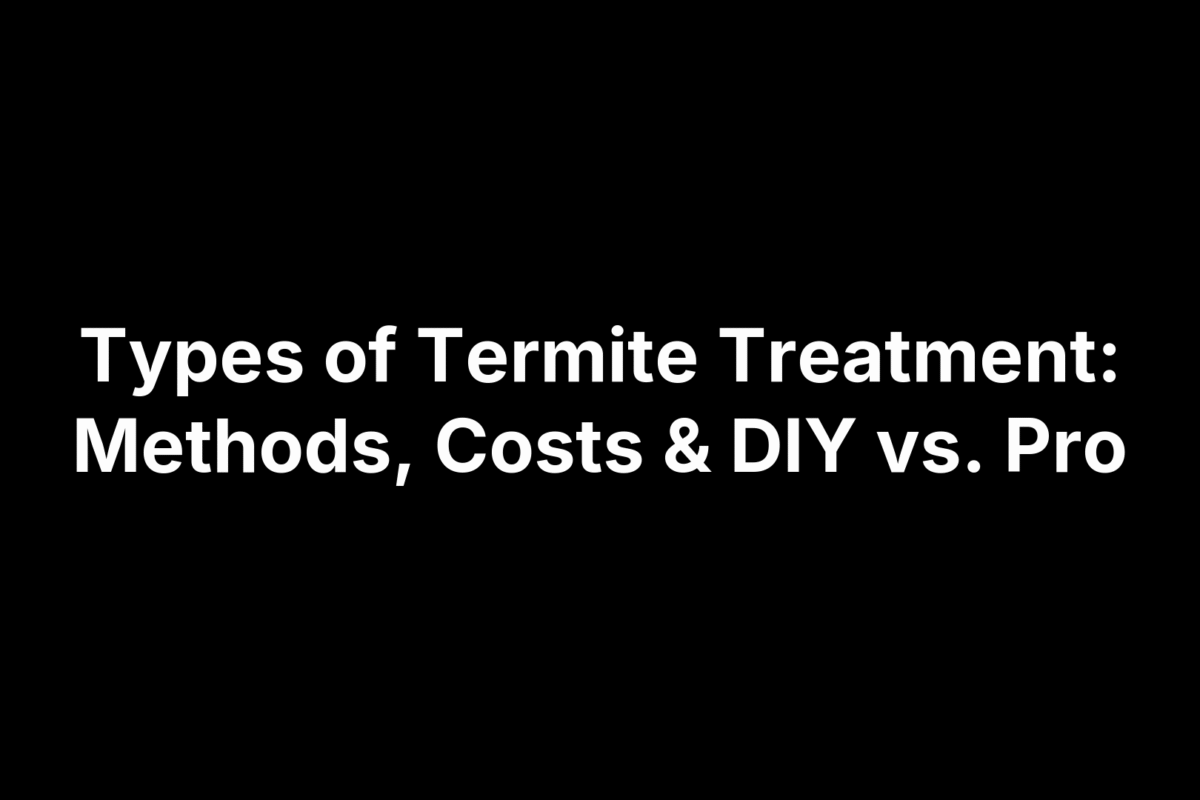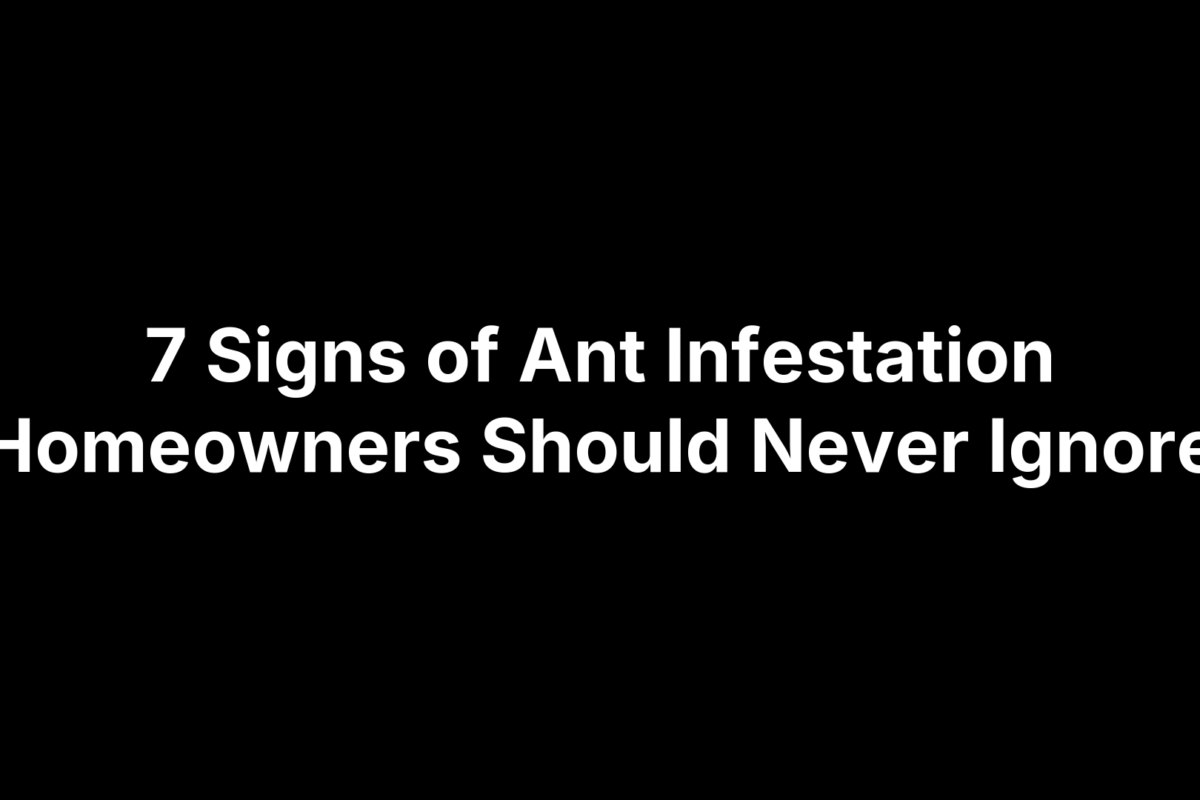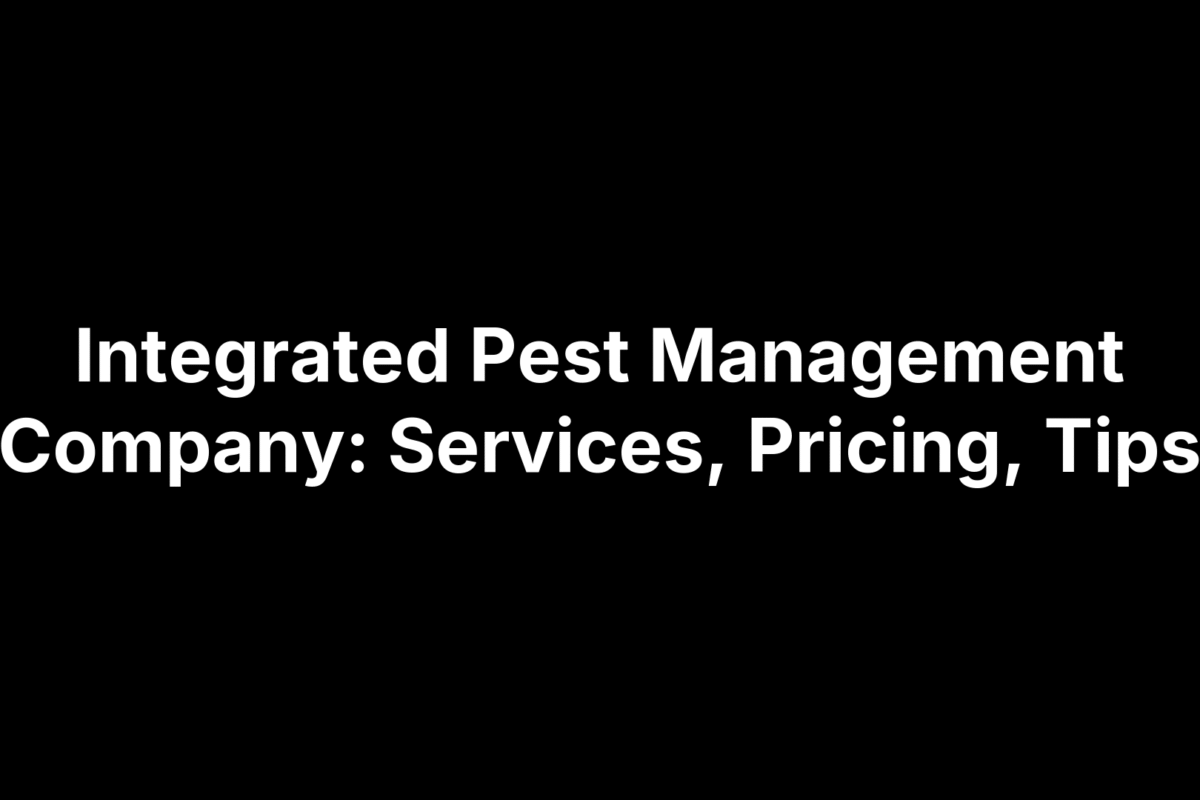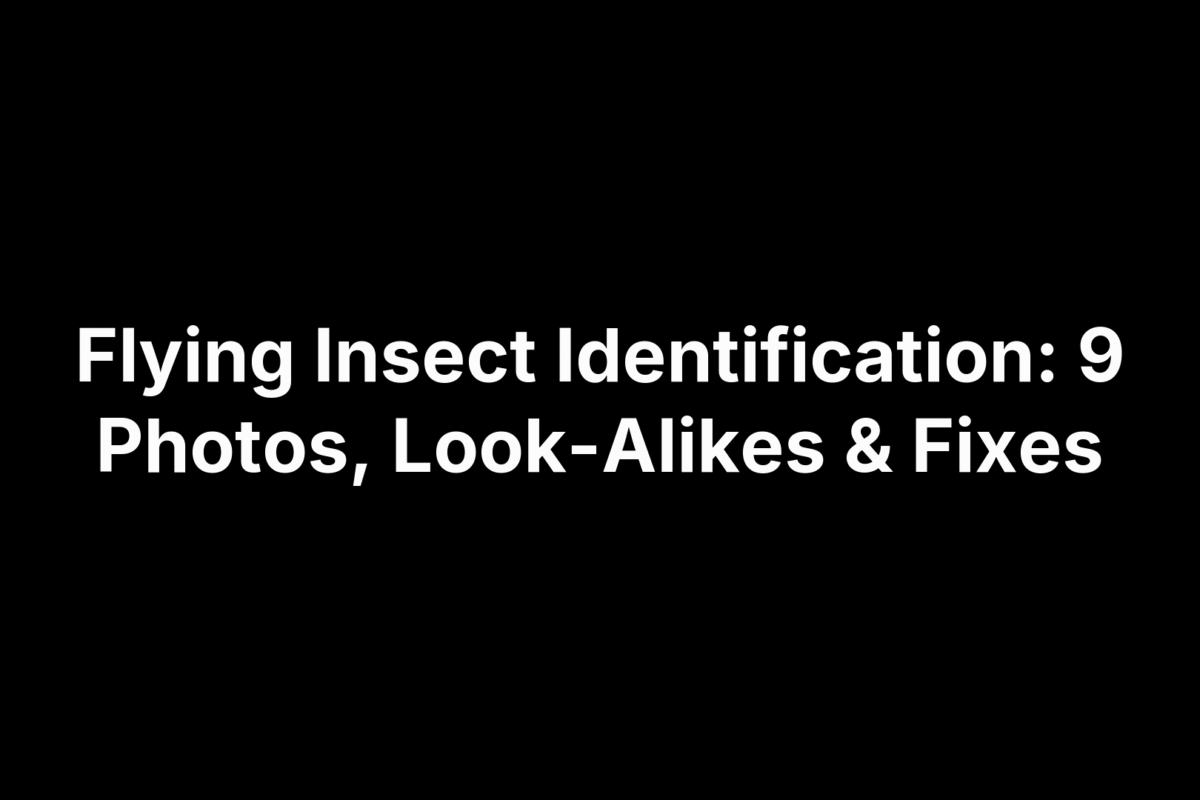Termites don’t announce themselves—they tunnel quietly through studs, subfloors, and trim until a soft spot, swarm, or mud tube gives them away. Once you notice signs, the clock is ticking: the longer you wait, the more extensive (and expensive) the repairs can get. Choosing the right pro isn’t simple either. Costs vary widely by species and method (bait, liquid, fumigation), and warranties and “bonds” differ by company. You need a provider you can trust, clear pricing expectations, and a guarantee that actually protects your home.
This guide ranks the 12 best termite control companies for 2025, balancing national reach with standout regional specialists. We compare what each offers (treatments, prevention, and monitoring), where they operate, inspection policies, warranties, eco and family-safety options, and typical price ranges—plus who each is best for. Whether you want the strongest repair guarantee or the fastest local response, you’ll find a fit here. If you’re seeing active signs, consider booking an inspection today. First up: our top local pick for speed and tailored plans.
1. Redi Pest Control LLC — fast local response and tailored termite plans
When termites show up, timing and precision matter. Redi Pest Control LLC stands out as a nimble, local-first provider that builds a termite plan around your structure—not the other way around. With experienced technicians, proven treatments, and a focus on safety, Redi blends speed with customization so homeowners, businesses, and property managers get results that last.
What they offer for termites
Redi designs comprehensive termite solutions using integrated pest management to eliminate colonies and prevent re‑infestation. Instead of one-size-fits-all treatments, they match methods to your construction type, risk factors, and activity level for targeted impact with minimal disruption.
- Tailored treatment plans: Customized combinations of baiting, liquid applications, and structural/exclusion recommendations.
- Prevention + monitoring: Strategies to reduce conducive conditions and keep activity from returning.
- Sector-specific expertise: Residential, commercial, industrial, and property management programs.
Service area and availability
As a local provider, Redi emphasizes responsiveness and clear communication throughout its service area. The team services homes and facilities across residential neighborhoods, retail and office spaces, warehouses, and managed communities—prioritizing quick scheduling when active termite signs are present.
- Fast local response: Streamlined scheduling and on-site visits designed to act quickly on evidence of activity.
- Discreet commercial service: Business-friendly timing to minimize interruptions.
Pricing, inspections, and guarantees
Every termite situation is unique, so Redi provides customized quotes following a professional assessment. Expect transparent recommendations tied to your property’s risk profile and treatment goals, with options that balance effectiveness and value.
- Custom pricing: Proposal based on species pressure, structure, and treatment scope.
- Professional inspection: Technician-led evaluation to confirm activity and map the plan.
- Satisfaction-focused service: Emphasis on safe, effective treatments and long-lasting results, with follow-up service as needed.
Best for and why we picked it
Choose Redi if you want a best termite control company experience without national call-center runaround. It’s ideal for homeowners who need fast action and for businesses/property managers who require tailored, discreet programs across multiple sites. We picked Redi for its combination of quick local response, integrated termite strategies, and competitive, needs-based plans that put safety and durability first.
2. Terminix — best overall for termite protection and repair guarantee
Terminix earns its spot as the best termite control company for homeowners who want broad treatment options and one of the strongest repair guarantees available. With free inspections, targeted solutions for every major termite species, and coverage across most of the country, it’s a reliable pick when you need results and long-term protection.
What they offer for termites
Terminix treats drywood, dampwood, and subterranean termites with plans built around your home and the infestation. Their approach spans immediate knockdown and prevention to keep colonies from rebounding, supported by helpful follow-up.
- Full toolkit: Liquid termiticides, bait systems, preventive sealing, and structural fumigation for drywood cases.
- Species-specific strategies: Targeted programs for subterranean, drywood, and dampwood termites across the U.S.
- Ongoing prevention: Monitoring and recommendations to remove conducive conditions and stop re‑infestation.
- Bundle option: Add the Pest365 plan (covers 13 common pests) to consolidate services and save on overall costs.
Service area and availability
Terminix operates at national scale while keeping scheduling simple. If you want a large provider that likely serves your ZIP, they’re a strong bet.
- Coverage: 45 states (not available in Alaska, Montana, North Dakota, South Dakota, or Vermont).
- Access: Online and phone scheduling with 24/7 customer support via phone and an online portal.
Pricing, inspections, and guarantees
Terminix starts with a free termite inspection—many competitors charge $50–$200—then customizes your estimate to species, structure, and severity. Costs vary by method and market, but the company publishes helpful benchmarks.
- Typical costs: Annual termite services often run $400–$1,500 (around $1,000 average), with comprehensive treatments averaging about $1,700; subterranean programs can be $400–$1,500 per year.
- Plans and savings: Termite service plans can start around $69/month; bundling with general pest control can save an average of $175–$295.
- Guarantees: The “Terminix It Guarantee” includes no-cost re‑treatments if termites return. The optional “It & Fix It” upgrade adds repair coverage for new termite damage up to $250,000 (terms vary by location).
Best for and why we picked it
Terminix is best for homeowners who want maximum peace of mind—especially in high-pressure termite regions or for older homes where repair risk is real. We chose it for its free inspections, breadth of treatments (including fumigation for drywood), and an industry-leading repair guarantee that goes beyond re‑treatments. While customer reviews are mixed on scheduling and billing experiences, the combination of scale, service options, and financial protection makes Terminix our best overall pick for termite protection and repair coverage.
3. Orkin — best national coverage and integrated pest management
If you want a best termite control company with near‑universal availability and a disciplined, science‑first approach, Orkin is hard to beat. Its integrated pest management (IPM) playbook, seasoned technicians, and QualityPro accreditation make treatments precise and consistent from market to market.
What they offer for termites
Orkin builds customized termite programs around species, structure, and moisture conditions, then layers treatments for elimination and prevention. After the initial knockdown, technicians return to verify results and adjust as needed.
- IPM-driven treatments: Targeted use of Termidor liquid, dry foam/OrkinFoam, and Sentricon bait and monitoring.
- Follow-up and prevention: Scheduled reinspections, conducive‑condition fixes, and clear homeowner recommendations.
- Home hardening add‑ons: Optional services that help deter future pressure, including attic insulation, moisture control, and gutter cleaning.
Service area and availability
Orkin’s national footprint means consistent protocols and parts availability almost anywhere you live. You get the scale of a large provider with standardized training and oversight.
- Coverage: 49 states (except Alaska) with 400+ branch locations.
- Access: 24/7 phone support plus online and phone scheduling for inspections and service windows.
Pricing, inspections, and guarantees
Termite pricing is always case‑by‑case. Orkin sets costs after an in‑home inspection from your local branch, then proposes a plan tailored to the species and severity on site.
- Customized quotes: No online termite pricing; estimates follow a property inspection and assessment.
- Guarantee: 30‑day money‑back guarantee if you’re not satisfied with the service.
- Professional standards: A+ BBB rating and NPMA QualityPro accreditation, signaling strong training, background checks, and operating ethics.
Best for and why we picked it
Orkin is best for homeowners and property managers who prioritize national coverage, consistent IPM protocols, and thorough follow‑through—especially if you may move or manage multiple properties across states. We picked it for its breadth (49‑state coverage), proven termite toolkit (Termidor, foams, Sentricon), rigorous technician training, and a straightforward money‑back guarantee. Note that quotes require an on‑site inspection and online price lists aren’t provided, which is typical for serious termite work.
4. Ehrlich Pest Control — eco-conscious treatments and bundled services
Ehrlich blends seasoned termite expertise with family- and pet‑conscious practices, making it a smart best termite control company pick for homeowners who want effective results without heavy chemical footprints. Technicians average 8+ years of termite experience and the company holds NPMA’s GreenPro accreditation, signaling rigorous training and environmentally responsible protocols.
What they offer for termites
Ehrlich builds a custom plan after inspecting your home, matching the treatment to the species, structure, and severity. The company prioritizes EPA‑registered products and offers complementary services that fix the conditions termites love, so results stick.
- Customized termite control: Targeted use of bait stations, liquid termiticides, spot treatments, and, when needed, fumigation.
- Eco- and family-conscious: EPA‑registered products with pet- and child‑safe options.
- Preventive add‑ons: Moisture control, heat treatments, and bioremediation to correct conducive conditions.
- Bundling options: Pair termite service with the PestFree365+ plan for broader pest protection.
Service area and availability
Ehrlich’s footprint is smaller than the big nationals, but coverage is deep where it operates and support is easy to reach. If you’re within its territory, you’ll get a seasoned local team and consistent protocols.
- Coverage: 19 states and Washington, D.C. (regional availability varies).
- Access: Phone scheduling with 24/7 phone support and live chat.
Pricing, inspections, and guarantees
Termite pricing is case‑by‑case. Ehrlich provides a free initial termite inspection, then delivers a tailored proposal based on findings. While it doesn’t advertise a money‑back guarantee like some competitors, it offers clear service commitments.
- Free initial inspection: No‑cost assessment for termites (and general pests).
- Personalized quotes: Pricing follows an on‑site evaluation; online tools don’t quote termite work.
- Guarantees: Customer satisfaction guarantee and a transferable treatment warranty in many cases (confirm terms locally).
Best for and why we picked it
Ehrlich is best for families prioritizing eco-conscious treatments, homeowners who want to bundle whole‑home pest protection, and properties with moisture or sanitation issues that need correction alongside termite elimination. We picked it for its GreenPro accreditation, experienced technicians, free inspections, and robust supplementary services that help prevent the next colony—not just the current one. Its limited footprint is the trade‑off; if you’re in service range, it’s an excellent, thoughtful choice.
5. Arrow Exterminators — Sentricon expertise in the Southeast
If you live in the Southeast—where termite pressure is intense—Arrow Exterminators is a standout best termite control company for sustainable, colony‑eliminating protection. Arrow pairs deep regional experience with the industry‑leading Sentricon baiting system and backs it with rigorous standards and eco‑focused practices.
What they offer for termites
Arrow centers its termite strategy on the Sentricon System, a proven baiting approach designed to wipe out entire colonies (the same system installed at high‑profile sites like the White House). The company’s STEPS program emphasizes using materials judiciously and responsibly, aligning effective control with environmental stewardship.
- Sentricon expertise: Monitors, baits, and eliminates colonies with minimal disruption to soil and landscaping.
- Sustainable approach: Company‑wide STEPS initiative to reduce risk to people, property, and the environment.
- Top accreditations: NPMA QualityPro and GreenPro credentials signal high operational and environmental standards.
- Prevention mindset: Ongoing monitoring and recommendations to remove conducive conditions.
Service area and availability
Arrow’s footprint is focused where homeowners need termite help most, delivering localized expertise and consistent protocols across its branches.
- Coverage: 12 states, primarily in the Southeastern U.S.
- Scheduling and support: Phone scheduling; customer support via phone and email (no 24/7 hotline; email responses typically within 1–2 days).
Pricing, inspections, and guarantees
Arrow doesn’t publish flat pricing because baiting density, structure type, and activity level drive the scope. Expect an inspection first, then a tailored proposal built around Sentricon and follow‑up monitoring.
- Inspection‑based quotes: Customized plans after a home assessment.
- Satisfaction guarantee: Clear customer satisfaction commitment; confirm specifics with your local branch.
- Maintenance options: Periodic monitoring and service visits to maintain a protective perimeter.
Best for and why we picked it
Arrow is best for Southeastern homeowners who want an eco‑forward solution with proven colony elimination and strong professional credentials. We picked it for its Sentricon specialization, GreenPro and QualityPro accreditations, and a company‑wide sustainability program that pairs effectiveness with responsibility. The trade‑off is availability: if you’re outside its 12‑state region—or need round‑the‑clock support—you’ll want one of the national providers above.
6. HomeTeam Pest Defense — built-in systems and new construction focus
Coordinating termite protection during a build or right after closing can save time, money, and headaches. HomeTeam Pest Defense stands out for working smoothly on new homes and planned communities, pairing prevention-first strategies with eco‑conscious standards. It’s GreenPro certified by the National Pest Management Association, signaling integrated pest management (IPM) practices and a lighter environmental footprint.
What they offer for termites
HomeTeam delivers inspection‑led, customized termite programs that combine elimination and ongoing prevention. Plans are tailored to structure type and risk, with options to monitor activity over time.
- Targeted treatments: Use of liquid termiticides, bait/monitoring systems, and spot applications matched to species pressure.
- Prevention mindset: Recommendations to correct conducive conditions and reduce future pressure.
- New‑home friendly scheduling: Builder- and buyer‑oriented coordination to align assessments and treatments with construction or move‑in timelines (availability varies by market).
Service area and availability
HomeTeam operates regionally through local branches. Because coverage varies, confirm service in your ZIP and ask about scheduling windows that align with your project or closing date.
- Regional coverage: Multiple local branches; availability differs by state.
- Access: Phone-based scheduling with branch support; response times vary by location.
Pricing, inspections, and guarantees
As with most serious termite work, pricing depends on the species involved, the size and complexity of the structure, and the treatment method. Expect an on‑site assessment first, followed by a written plan.
- Inspection‑based quotes: Custom proposals after a professional evaluation.
- Plan options: One‑time knockdown with follow‑up or ongoing monitoring/maintenance.
- Assurances: Warranty and re‑service terms are set locally—review coverage length, what’s included, and any annual inspection requirements before you sign.
Best for and why we picked it
HomeTeam is a smart pick if you’re building, buying new, or managing multiple homes in a development and want a best termite control company that can coordinate smoothly around construction schedules. We chose it for its prevention‑first approach, branch‑level expertise, and GreenPro certification—hallmarks of thoughtful IPM. If new‑construction timing and standardized service matter, put HomeTeam on your short list and verify local availability and warranty details up front.
7. Massey Services — strong termite bonds and Sunbelt coverage
In warm, termite‑heavy climates, you want a provider that thinks long‑term: eliminate the colony now and keep pressure down year after year. Massey Services fits that brief as a regional option many Sunbelt homeowners consider, with inspection‑led plans and renewable protection that functions like a traditional “termite bond.”
What they offer for termites
Massey builds treatment around what’s actually attacking your structure, then layers prevention so activity doesn’t rebound. Expect an inspection first, followed by a custom plan that balances fast knockdown with ongoing monitoring and maintenance.
- Customized treatment mix: Targeted use of liquid termiticides, bait/monitoring systems, and spot applications.
- Prevention and monitoring: Ongoing checks and recommendations to fix conducive conditions (moisture, wood‑to‑soil contact).
- Renewable protection: Annual service agreements designed to maintain a protective perimeter and catch activity early.
Service area and availability
Massey focuses on Sunbelt markets where termite pressure is consistently high. Availability and scheduling are handled locally through branch teams, so response times and appointment windows can vary by ZIP.
- Regional footprint: Coverage in select warm‑weather states; confirm service in your area.
- Local scheduling: Branch‑based coordination for inspections, treatments, and follow‑ups.
Pricing, inspections, and guarantees
Serious termite work is never one‑price‑fits‑all. You’ll receive a proposal after an on‑site evaluation of species, structure, and severity. Industry‑wide, ongoing termite services often run $400–$1,500 annually depending on method and risk; your quote may differ based on your plan and market.
- Inspection‑based quote: Written scope and line‑item recommendations after a property assessment.
- Renewals: Yearly maintenance agreements are common; ask about what’s included at renewal.
- Coverage terms: Clarify re‑treatments, any repair coverage, caps, and prerequisites (e.g., moisture corrections).
- Payment options: One‑time treatments vs. annual plans—compare total cost of ownership.
Best for and why we picked it
Massey is best for homeowners in high‑pressure Sunbelt zones who want a best termite control company experience built around renewable protection—annual inspections, monitoring, and clear service terms. We included it for its branch‑driven approach in warm‑weather markets and its emphasis on ongoing agreements that keep defenses active between swarm seasons. Confirm exact coverage, warranty, and repair terms with your local branch before you sign.
8. Bulwark Exterminating — family-friendly products and high satisfaction
Bulwark Exterminating is a reader favorite for families that want effective termite elimination with gentler, research‑backed products and a strong service promise. The company emphasizes eco‑conscious practices (like backpack spraying and paperless ops) and claims some formulations are less toxic than toothpaste, with certain actives naturally derived from chrysanthemum flowers. Pair that with high customer marks and an A+ BBB rating, and you get a people‑first provider with proven results.
What they offer for termites
Bulwark builds a custom plan around your structure and the colony’s behavior, then combines methods for fast knockdown and long‑term prevention. After the initial service, most homes won’t need interior treatments unless activity resurges.
- Customized solutions: Liquid perimeter/barrier applications plus bait and monitoring as needed.
- Integrated approach: Targeted treatments with recommendations to remove conducive conditions.
- Satisfaction focus: If pests pop up between visits, Bulwark returns to re‑treat.
Service area and availability
Bulwark serves select markets with technicians trained for regional termite pressures, especially in warmer climates where activity is highest. Availability is strongest across the South and Southwest.
- Coverage: 14 U.S. states (regional availability varies; confirm by ZIP).
- Local teams: Branch‑level scheduling and service for faster, consistent follow‑through.
Pricing, inspections, and guarantees
Termite pricing is tailored after an inspection, since species, structure, and severity drive scope. During third‑party secret shopping, sample prices for an initial treatment in Arizona ranged from $200–$350, but rates vary widely for termite work based on activity and methods used.
- Inspection‑based quotes: Written proposals with scope and treatment mix.
- 100% satisfaction guarantee: Free re‑service between scheduled visits if issues arise.
- Cost drivers: Species, home size, construction type, and treatment method.
Best for and why we picked it
Bulwark is best for families prioritizing lower‑toxicity products and homeowners who want a personable, high‑satisfaction experience with a clear re‑service promise. We picked it for its eco‑leaning formulations, customized barrier‑plus‑bait strategies, and strong customer ratings. Note the trade‑offs: a 14‑state footprint limits availability, and a minority of reviewers have cited aggressive marketing—so opt in to communications you want and review terms before signing.
9. Hawx Pest Control — quick baiting systems and affordable maintenance
Hawx focuses on speed and simplicity: get bait stations in the ground fast, collapse the colony, then keep costs predictable with low‑friction maintenance. If you want an eco‑leaning option that minimizes soil termiticide exposure and values quick results, Hawx is worth a look—especially if you prefer subscription‑style upkeep.
What they offer for termites
Hawx prioritizes its bait‑first approach to reduce chemical exposure and speed up results. After an inspection, technicians deploy stations around the structure and return to confirm activity is trending down while tightening up conducive conditions.
- Proprietary baiting system: Stations placed roughly every 10 feet around the home to disrupt termite reproduction; Hawx reports results in about one month.
- Lower soil impact: Baiting avoids broad soil applications, making it a more eco‑friendly route for many homes.
- Free re‑services: If pests re‑emerge between visits, Hawx returns at no extra charge.
Service area and availability
Hawx is a regional provider with a growing footprint and a focus on exterior protection programs. Check ZIP‑level availability before you plan, as termite pressure and service options can vary by branch.
- Coverage: 16 states.
- Scheduling: Local branch coordination for inspections and installations; follow‑ups aligned to your maintenance plan.
Pricing, inspections, and guarantees
Termite quotes are inspection‑based. During secret shopping, Hawx offered competitive pricing with occasional perks that make maintenance easier to stomach over time.
- Promotions: Examples include $150 off termite services and monthly maintenance plans starting around $45 with a limited‑time offer (promos vary by market).
- Inspection‑led quotes: Written scope after a site assessment; pricing depends on structure size, activity, and station density.
- Service promise: Free re‑service between visits if pests return.
Best for and why we picked it
Hawx is best for homeowners who want fast‑acting bait systems, minimal soil termiticide use, and affordable ongoing maintenance. We included it for its quick deployment model, eco‑minded approach, and budget‑friendly plans. Note the trade‑offs: availability is limited to 16 states, the BBB rating sits at B, and some customers report aggressive sales and cancellation friction on monthly plans. If you choose Hawx, lock in the promo details and cancellation terms up front.
10. American Pest — trusted Mid-Atlantic specialist
American Pest is a solid pick if you want a best termite control company with a regional focus and straightforward service. Known for clear plan options and a customer-friendly pledge, it brings consistent, inspection-led treatment and ongoing prevention that fits how Mid-Atlantic homes are built and attacked.
What they offer for termites
American Pest centers its termite work on confirming activity, mapping pressure points, and building a plan to eliminate the colony and prevent rebounds. Homeowners can choose coverage that matches their risk and budget without overcomplicating the process.
- Inspection-led plan: A tailored scope based on structure, species pressure, and severity.
- Flexible coverage: Options for one-time remediation or seasonal/ongoing coverage to stay ahead of swarm season.
- Simple plan structure: Clear inclusions so you know what’s treated, monitored, and re‑serviced if needed.
Service area and availability
This is a Mid-Atlantic specialist with a regional footprint and local technicians who understand area construction types, moisture patterns, and swarm timing. Because availability varies by branch, confirm ZIP-level service and next open inspection windows before you plan repairs.
- Regional focus: Built for Mid-Atlantic conditions and building styles.
- Local scheduling: Branch teams coordinate inspections, treatments, and preventive follow-ups.
Pricing, inspections, and guarantees
Termite pricing is customized after inspection, which is standard for serious termite work. Expect a written scope with simple plan choices and renewal options. Industry benchmarks place many annual termite programs in the $400–$1,500 range depending on method and risk, though your quote will reflect your home and plan.
- Simple plans and pricing: Transparent options you can compare at a glance.
- One-time or seasonal coverage: Pick eradication only or add maintenance for prevention.
- Pest‑Free Pledge Guarantee: A service promise to address issues that crop up between scheduled visits.
Best for and why we picked it
American Pest is best for Mid-Atlantic homeowners who want regional expertise, straightforward plan choices, and a clear service pledge. We included it for its simple pricing approach, flexible one-time or seasonal coverage, and the Pest‑Free Pledge Guarantee that adds confidence between visits. It’s a strong, no‑drama option when you want dependable local service and predictable protection.
11. Clark Pest Control — West Coast drywood and fumigation experts
Drywood termites are a different beast from their subterranean cousins, and West Coast homes encounter them often. That’s why many homeowners consider Clark Pest Control when they need inspection‑led plans that include spot treatments for localized galleries and full‑structure fumigation when an infestation is widespread. If you’re comparing the best termite control company options in drywood country, make sure your provider can do both—precisely and safely.
What they offer for termites
Clark approaches termites with a toolbox designed for how West Coast homes are built and how drywood colonies behave. Expect an inspection first, then a plan that pairs elimination with prevention so activity doesn’t rebound.
- Drywood solutions: Localized spot/drill‑and‑treat for contained pockets; whole‑structure fumigation (tenting) when activity is dispersed.
- Subterranean coverage: Trench‑and‑treat liquid barriers and bait/monitoring where soil‑borne pressure is present.
- Prevention and monitoring: Moisture and ventilation guidance, sealing utilities/penetrations, and scheduled reinspections.
Service area and availability
Availability varies by branch and season, especially around spring/summer swarms when calendars fill quickly. If you’re seeing pellets, blistered paint, or swarmers, get on the schedule early and ask for the first open inspection window.
- Regional focus: Built for West Coast building styles and local termite pressures.
- Flexible scheduling: Coordination for homeowners, businesses, and property managers; discreet service options for commercial sites.
Pricing, inspections, and guarantees
Termite work is never one‑size‑fits‑all. You’ll receive an inspection‑based quote with written scope, methods, and follow‑ups. Industry research places common ranges here, which can help you sanity‑check bids.
- Inspection‑based quotes: Many providers charge $50–$250 for inspections; some offer them free—confirm locally.
- Typical ranges (method‑dependent): Spot chemical $200–$800; bait/chemical programs $300–$2,500; heat $1,000–$6,000; tenting/fumigation $2,000–$8,000+.
- Guarantees to seek: Re‑treatments if activity returns, and clearly written warranty terms (coverage length, any repair limits, required annual checks).
Best for and why we picked it
Clark is best for West Coast homeowners facing drywood pressure—especially older coastal homes, multi‑family buildings, or cases where structural fumigation may be the fastest, most complete reset. We included Clark for its drywood depth and whole‑structure capabilities alongside standard subterranean treatments, giving homeowners a single source for inspection, elimination, and prevention. As with any provider, confirm branch‑level availability, inspection fees, and warranty terms before you sign.
12. Truly Nolen Pest Control — recognizable brand with comprehensive plans
If you prefer a single, recognizable provider that can handle termites and broader pest concerns under one roof, Truly Nolen fits the bill. The brand focuses on inspection-led service, elimination, and prevention, with the kind of consistency homeowners look for when they want one company to manage ongoing protection.
What they offer for termites
Expect an inspector to confirm activity and risk areas first, then build a targeted plan to eliminate the colony and reduce conducive conditions so it doesn’t rebound. As with reputable providers, prevention is part of the conversation—not just today’s treatment.
- Inspection-driven plan: Scope tailored to your structure, species pressure, and severity.
- Targeted elimination + prevention: Treatment paired with fixes for moisture, wood-to-soil contact, and entry points.
- Whole-home simplicity: Ask about packaging termite protection alongside general pest service to simplify scheduling.
Service area and availability
Truly Nolen operates through local branches with market-specific offerings. Because termite pressure and service menus vary by region, confirm ZIP-level availability and the next open inspection window before you plan repairs or renovations.
- Local branch support: Scheduling and follow-ups coordinated by nearby teams.
- Regional variations: Treatment options and maintenance plans may differ by market.
Pricing, inspections, and guarantees
Serious termite work is never one-price-fits-all. You’ll get a written quote after an on-site inspection that maps activity, construction details, and the treatment mix. Use industry ranges to sanity-check bids and clarify warranty terms before you sign.
- Inspection-based quote: Custom pricing after evaluation; scope drives cost.
- Helpful industry benchmarks: Many annual programs run $400–$1,500; method-dependent work can range from spot chemical ($200–$800) to bait/chemical ($300–$2,500) and tenting/fumigation at $2,000–$8,000+.
- Warranty clarity: Review re-treatment terms, coverage length, any repair limits, and required annual inspections.
Best for and why we picked it
Truly Nolen is best for homeowners who want a recognizable brand and a comprehensive, maintenance-focused experience with straightforward scheduling. We included it for its full-service approach—inspection, elimination, and prevention under one umbrella—and the ability to keep protection consistent season after season. As always, verify your local branch’s availability, plan details, and warranty terms to make sure the coverage matches your home’s risks and budget.
Next steps
You’ve got a clear picture of who does what and where they shine. Now move fast and methodically: termites don’t pause, and early action saves you money. Line up quotes, pressure‑test warranties, and make sure the treatment plan fits your home’s construction and the species on site.
- Get 2–3 quotes: Ask about species ID, method (bait/liquid/fumigation), timeline, and repair caps.
- Leverage free inspections: Some providers offer them; confirm what’s included and any obligations.
- Document activity: Photograph mud tubes, swarmers, or frass; note leaks, wood‑to‑soil contact, and moisture.
- Plan the budget: Many annual programs run ~$400–$1,500; fumigation can cost more.
- Prioritize speed + protection: Choose earliest availability with strong re‑treat/repair terms.
If you’re ready to act now and want fast, local expertise, schedule a local inspection with Redi Pest Control and get a tailored plan that puts protection in place this week.
